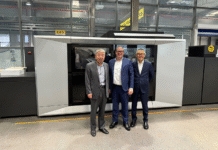
Redington Limited introduced its first HP Indigo digital press in the Indian market in the year 2003. Since then, the Chennai-headquartered authorized distributor of HP Indigo digital press has installed 275 presses across India, providing their services in 130 cities.
“At Redington, we try to reduce technology friction. We do have technologies available, but it has to go to the end user. We are upskilling ourselves on that front and training people to get the technology to the end user,” says Ramesh KS, vice-president, digital printing, Redington Limited.
Having the HP Indigo 15k, 7k, 6k, 25k, and HP Indigo 100k digital presses in its roster, Redington caters to the photo industry, commercial printers, labels, and packaging industry. “Being a digital press and not a small printer, HP Indigo was purely meant for commercial. But the photo segment came as a surprise. Since the quality of print is impeccable and the photo industry was looking for an alternative, it was well-accepted by the industry. Most of the wedding albums printed in India are printed in Indigo,” Ramesh says.
“Since weddings in India are not going to die, we see a good potential for the Indigo digital press in the photo printing segment,” he said. The photo segment takes a 65% slice of the combined photo, commercial, label, and packaging industry market for Indigo presses in India. The other three – commercial, label, and packaging – account for the remaining 35%.
Digital revolution
In the evolving landscape of printing, digital printing is the new trend that’s been revolutionizing the printing industry. Ramesh believes digital printing plays an important role in short-run and fast-paced printing jobs.
“Nowadays corporates are not investing large amounts in any product as customer habits and choices are changing in a short span due to the fast-changing scenario. So they don’t want to invest in a product that’s not going to last for more than a few months,” Ramesh says. “Looking at the sustainability factor, the corporates don’t want to print, keep, and waste. It’s better to invest for short-run jobs rather than for longer-run jobs.”
Highlighting the context of short-run jobs and a fast-paced consumer environment, he shed light on the minimized shelf-life of a product in the marketplace. This decrease in product shelf-life has led to an increase in the demand for digital printing, he says.
“Quick turnaround time is the biggest advantage of shifting to digital. The companies keep the product on the shelf, they see how it goes, and if they want to change anything, they can change immediately,” he says. The fast-paced consumer environment is now looking for personalized and customized products, which is possible only through digital printing.
Serving the commercial printers, labels, and packaging industry, Ramesh says the packaging industry is taking more advantage of the digital revolution than commercial printers. “Although due to the digital intervention, the commercial printers saw a good momentum post-Covid due to the large number of SKUs, it is the packaging industry that has an extra edge due to the variations in the industry.”
He emphasized that start-ups are highly benefitting from digital printing as it not only meets their immediate needs but also provides a cost-effective solution for small-scale production.
Role of manufacturers
Discussing the role of manufacturers, Ramesh says rather than just launching a new press, they look for the applications first and then go for an upgrade or launch a new press. “The manufacturer’s new trend is more application-driven than just being product-driven,” Ramesh says.
Redington’s Center of Excellence

Any innovation in the market needs to be properly shown, as the customer needs to verify the machine, the quality of output, and the applications in the real world before investing. Established in January 2017, the Redington HP Indigo Center of Excellence (COE) provides a physical environment for customers to witness the machines and check their specifications.
“The print quality from HP Indigo is like that from an offset press or sometimes better than offset prints. It was a new technology when introduced into the market for the first time. Customers need to know about this technology and witness it in the physical environment. This is where the demo center helps us and the customer to know about the machine before investing,” Ramesh says.
At the center, Redington provides training to customers to run the machines, trains students from institutions, and conducts seminars and workshops for the students to come and explore the world of digital printing. As digital printing is coming up as a new subject, this practical exposure will help the students better understand the subject.
“The COE serves our motto of reducing the technology friction and making it available for the end user,” said Ramesh.
















